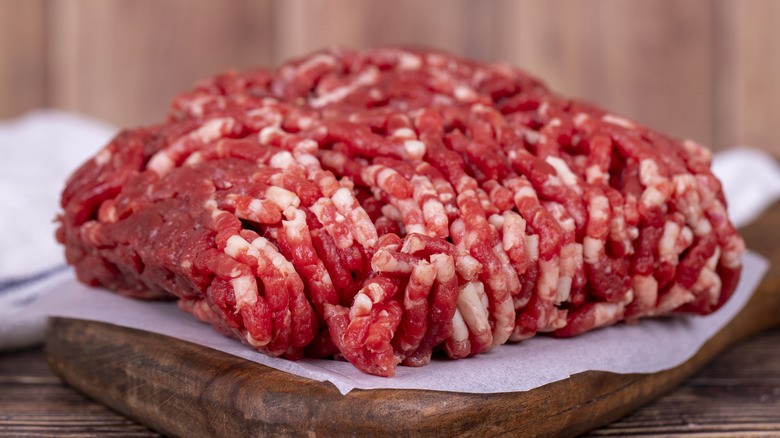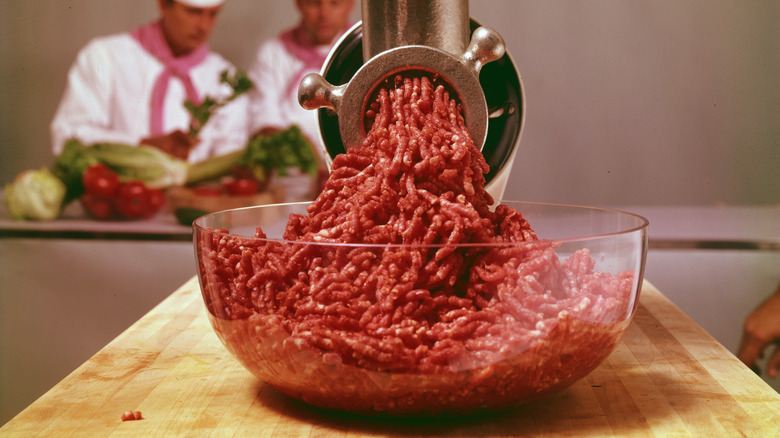Why People Eat Mounds Of Raw Ground Beef For Christmas In Wisconsin
Christmastime at a Wisconsin table features American holiday staples like ham, mashed potatoes, and cookies, but the appetizer course often features something that would shock non-Midwesterners. It's called a cannibal sandwich, even though it's not exactly a sandwich, and does not, in fact, involve Hannibal Lecter's favorite activity. The dish is quite simple — a slice of rye bread topped with raw ground beef and a few slices of onion (also raw). The meat is typically seasoned with salt and pepper and doesn't have much of a taste on its own. The focus is more on texture, with the soft, spreadable meat contrasting the crusty bread and crisp onions.
Raw beef can be found on tables throughout the Upper Midwest, and depending on where you are, it may also be called "tiger meat" or "wildcat." However, the dish is most closely associated with Wisconsin, where beef and dairy dominate the agricultural scene. It is particularly popular in the Milwaukee area, and you can even find it at local restaurants and butchers, especially during the Christmas season.
Despite its enduring popularity, the cannibal sandwich is a highly controversial dish. People have eaten raw beef for centuries (consider the long history of beef tartare), but doctors and health officials have consistently warned of its potential dangers. Cannibal sandwiches can be safe as long as you take precautions. However, it can still be risky.
The history of cannibal sandwiches
The tradition of eating cannibal sandwiches can be traced to German immigrants in the Midwest, although it's unclear how it became associated with Christmas. There is a similar German dish called mett, which is traditionally made with ground or minced pork, although on rare occasions, beef may be used instead. Like the cannibal sandwich, mett is often paired with raw onion (in which case it is called "zwiebelmett) and served on bread ("mettbrötchen").
The Midwest, particularly Wisconsin, experienced a massive wave of immigrants from Germany in the 1800s. Today, 37.1% of Wisconsinites identify as German-American, the most of any state according to World Population Review, and Germans make up the largest immigrant community in Milwaukee.
Although pork is the traditional choice for mett, cattle is far more prevalent in dairy-centric Wisconsin, so beef became the meat of choice for cannibal sandwiches. Access to fresh beef played an essential role in keeping the tradition of raw meat alive, and if German immigrants had concentrated in a different, less agriculturally-inclined region, the cannibal sandwich probably wouldn't exist. Even today, the dish's future is uncertain as its popularity fluctuates and fears of food poisoning intensify.
Is it really safe to eat a cannibal sandwich?
Cannibal sandwiches are extremely controversial. Health authorities have repeatedly warned people to avoid the dish, arguing that it's never safe to eat raw meats of any kind. Ground beef is especially worrisome. Harmful bacteria such as salmonella and E. coli gather on the exposed surfaces of meat, and typically, any risk of contamination is eliminated when the exterior of the meat hits a hot pan, grill, or oven. However, grinding meat dramatically increases the exposed surface area and distributes bacteria throughout the mix. That's why the USDA recommends a higher internal temperature for ground beef — a minimum of 160 degrees Fahrenheit, which is firmly in the well-done range.
If you're going to make cannibal sandwiches, you need to be very careful where you get your meat from. Even if you choose the best ground beef at the grocery store, you're still at risk because it could have been sitting in its package for a few days. You need the beef as freshly-ground as possible, so avoid the supermarket and head to a local butcher. Let them know you'll be eating the meat raw, and ask for it freshly-ground to order. Better yet, buy a whole piece of beef and grind it yourself at home.


